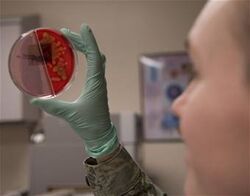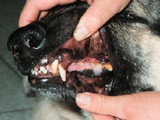All types of infection are dangerous to diabetics, because they usually cause hyperglycemia [1] and can also cause ketoacidosis. Illness places the body under stress, which can raise blood glucose levels. It also goes to work trying to rid itself of the problem; this causes some hormonal release of some of the same counter-regulatory hormones the body releases when it feels it's being threatened with hypoglycemia. [2] This can make it difficult to keep in good control using the same amount of insulin when there's no illness. Humans with diabetes have "sick day" plans; on those days, more insulin, more blood glucose testing and checking for ketones may be needed. See the Corrective insulin page for information on how infections can raise blood glucose levels and why additional short-acting insulin may be needed.
Infections are also capable of causing hypoglycemia. [3][4]
Illness also brings with it a need to monitor blood sugar levels more often and to possibly monitor for ketones. [5]

A urine culture-one of the tools in detecting infections and also in finding the right antibiotic for them.
Keep in mind that infections may be invisible without a blood test and urine cultures. [6][7][8]
All with diabetes--pets and people--are more prone to all types of infections than their non-diabetic counterparts. Having diabetes affects your immune system, which is what helps fight off both infections and diseases, such as colds and flu, etc. When the immune system doesn't or can't do this properly, more problems with infections and/or illness can result; it can take a diabetes patient longer to clear up an infection than a patient without diabetes. [9]
As an instance, dogs with diabetes have been found to be more subject to skin infections than non-diabetics. This study concluded that diabetic dogs are prone to skin problems, particularly bacterial and yeast-induced dermatitis and otitis. [10]
Diabetics of all species are more prone to urinary tract infections than non-diabetics.[11] The increased sugar content of the urine provides a more amenable environment for them. [12]. Those with diabetes are more at risk for any type of infections because their immune system doesn't work properly [13] Untreated bladder infections can easily become kidney infections, which pose more problems for those with diabetes. [14]
A 2004 ACVIM study [15] details the connection between humans with diabetes and pulmonary (of the respiratory system, including the lungs) conditions such as pneumonia. Pneumonia is a common cause of death in persons with diabetes. Until this study, nothing similar had been done regarding determining if this was also true for diabetic dogs and cats. In 15 cases, there were no clinical signs or symptoms of respiratory conditions, but abnormal findings were discovered in the lungs of 12 of the 15 cases. This was a small study and no statistically significant differences were discovered. However, it serves to add credence to the investigators' theory that there is also a higher incidence of pulmonary-related problems present in diabetic dogs and cats. The thought is that by monitoring the respiratory system for signs of problems, some may discovered and treated before they have serious consequences.
References[]
- ↑ Illness. Abbott Diabetes Care UK.
- ↑ When You're Sick. American Diabetes Association.
- ↑ Hypoglycemia in Dogs. Petplace.com.
- ↑ Hypoglycemia. Cornell University.
- ↑ Ketosis. Novo Nordisk.
- ↑ McGuire NC, Schulman R, Ridgway MD, Bollero G. (2002). Detection of Occult Urinary Tract Infections in Dogs with Diabetes Mellitus. Journal of the American Animal Hospital Association.
- ↑ Retrospective Evaluation of Urinary Tract Infection in 42 Dogs with Hyperadrenocorticism (Cushing's Disease) or Diabetes Mellitus or Both-Journal of Veterinary Internal Medicine-1999
- ↑ Schermerhorn, Thomas (2001). Persistent Hyperglycemia in Dogs and Cats-pages 10-11. Standards of Care-Compendium.
- ↑ Schermerhorn, Thomas (January 2008). Diabetes Mellitus in Dogs and Cats. NAVC-Clinician's Brief.
- ↑ Peikes, Heather, Peikes, Morris, Daniel O., Hess, Rebecka S., (2001). Dermatological Disorders in Dogs With Diabetes Mellitus: 45 Cases. Journal-American Veterinary Medical Association.
- ↑ Daniels, Joshua B., Chew, Dennis J. (2011). Diagnosis and Treatment of Routine and Difficult Urinary Infections in Dogs. Western Veterinary Conference.
- ↑ Gulf Coast Veterinary Specialists-Diabetes Mellitus
- ↑ Diabetes Mellitus. Gulf Coast Veterinary Specialists.
- ↑ Kirsch, M. (1998). Incidence of Bacterial Cystitis in Diabetic Dogs and Cats at the Time of Diagnosis. Retrospective Study for the Period 1990-1996. Tierartzlische Praxis: Ausgabe K Kleintiere/Haustiere-Abstract in English.
- ↑ Abstract#62-Diabetes & Respiratory System Disorders-page 23. ACVIM (2004).
More Information[]
- Diabetes and Periodontal Infection: Making the Connection Southerland, Janet H., et. al., 2005, Clinical Diabetes
This is an article regarding people with diabetes but it is a good general one because it discusses dental problems unique to those with diabetes. - Troubleshooting Persistent Hyperglycemia in Treated Diabetics-Microbial Infection Schermerhorn, Thomas, 2008, WSAVA
- Insulin Resistance Due to Periodontal Disease in an Old Diabetic Female Poodle A.G. Pöppl1, F. Müller, L. Queiroga,; I. Oliveira, 2009, WSAVA
- Changes in Peripheral Lymphocyte Subsets in Diabetic Dogs Treated with Insulin Mori, Akihiro, et. al., 2007, Japan Veterinary Medical Society
- Vetsulin-Insulin Requirement Changes in Dogs Intervet
- Vetsulin-Insulin Control-Insulin Resistance Intervet
- Canine Diabetes Mellitus-Clinical Signs Herrtage, Michael, 2009, WSAVA
- Infectious Diseases and the Kidney Goldstein, Richard E., 2010, WSAVA
All items (4)





